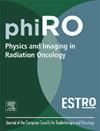Advancing offline magnetic resonance-guided prostate radiotherapy through dedicated imaging and deep learning-based automatic contouring of targets and neurovascular structures
IF 3.3
Q2 ONCOLOGY
引用次数: 0
Abstract
Background and Purpose
Erectile dysfunction (ED) affects quality of life following radiotherapy for prostate cancer. Magnetic resonance imaging (MRI) planning provides superior visualization of potency-related anatomical structures compared to computed tomography (CT), enabling improved sparing. However, contouring these structures in clinical practice is time-intensive and requires expertise. Deep learning (DL) auto-contouring with MRI simulation could make neurovascular-sparing radiotherapy more accessible.
Material and Methods
High-resolution 3D T2-weighted SPACE MRI sequences (<1 mm3 resolution) were obtained for 50 patients in treatment position. An expert uro-radiation oncologist contoured erectile function-related anatomy (neurovascular bundles [NVB], pudendal arteries [IPA], penile bulb [PB], corpora cavernosa [CC]) and target structures (prostate [PR], seminal vesicles [SV]). Forty datasets trained and ten tested a 3D nnU-net model. DL-generated contours were geometrically evaluated (surface Dice Score [sDSC], mean surface distance [MSD]) and validated by blinded expert review.
Results
DL auto-segmentation achieved an average sDSC of 0.82 (IPA: 0.93, NVB: 0.71, PB: 0.84, CC: 0.90, PR: 0.74; SV: 0.79) and average MSD of 0.74 mm (IPA: 0.61 mm; NVB: 0.88 mm; PB: 0.63 mm; CC: 0.47 mm; PR 0.83 mm; SV: 1.01 mm). Blinded ratings showed no significant differences between DL and expert contours, except for pudendal arteries (Mean DL vs. expert; NVB: 82 vs. 85; PB: 86 vs. 88; CC: 83 vs. 88; PR 81 vs. 83; SV 78 vs. 81 all p > 0.05; IPA: 82 vs. 89; p = 0.028).
Conclusion
Combining high-resolution MRI simulation with DL postprocessing enables accurate auto-contouring for MR-guided SBRT planning, potentially advancing neurovascular-sparing radiotherapy beyond current standards.

通过专用成像和基于深度学习的目标和神经血管结构自动轮廓,推进离线磁共振引导前列腺放疗
背景与目的勃起功能障碍(ED)影响前列腺癌放疗后的生活质量。与计算机断层扫描(CT)相比,磁共振成像(MRI)规划提供了更好的与电位相关的解剖结构的可视化,从而提高了节约。然而,在临床实践中塑造这些结构是费时的,需要专业知识。MRI模拟的深度学习(DL)自动轮廓可以使神经血管保留放射治疗更容易获得。材料与方法对50例患者在治疗体位获得高分辨率三维t2加权SPACE MRI序列(<;1 mm3分辨率)。一位泌尿放射肿瘤学专家绘制了与勃起功能相关的解剖图(神经血管束[NVB]、阴部动脉[IPA]、阴茎球[PB]、海绵体[CC])和靶结构(前列腺[PR]、精囊[SV])。训练了40个数据集,其中10个测试了一个3D nnU-net模型。对dl生成的轮廓进行几何评估(表面Dice Score [sDSC],平均表面距离[MSD]),并通过盲法专家评审进行验证。结果dl自动分割的平均sDSC为0.82 (IPA: 0.93, NVB: 0.71, PB: 0.84, CC: 0.90, PR: 0.74, SV: 0.79),平均MSD为0.74 mm (IPA: 0.61 mm, NVB: 0.88 mm, PB: 0.63 mm, CC: 0.47 mm, PR: 0.83 mm, SV: 1.01 mm)。除阴部动脉外,盲法评分显示DL和专家轮廓之间无显著差异(平均DL与专家;NVB: 82对85;PB: 86对88;CC: 83对88;PR 81对83;SV 78对81,均p >; 0.05; IPA: 82对89;p = 0.028)。将高分辨率MRI模拟与DL后处理相结合,可以为mr引导下的SBRT规划提供准确的自动轮廓,有可能使神经血管保留放疗超越当前标准。
本文章由计算机程序翻译,如有差异,请以英文原文为准。
求助全文
约1分钟内获得全文
求助全文
来源期刊

Physics and Imaging in Radiation Oncology
Physics and Astronomy-Radiation
CiteScore
5.30
自引率
18.90%
发文量
93
审稿时长
6 weeks
 求助内容:
求助内容: 应助结果提醒方式:
应助结果提醒方式:


